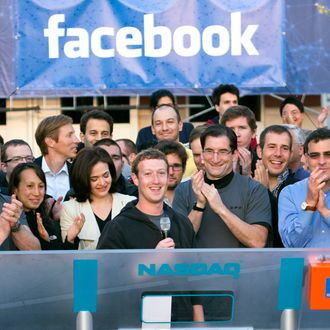
If you were the chief executive of a major stock exchange, and you’d just finished attending the bell-ringing of the most hyped IPO in your exchange’s history, and you knew that investors were on hair-trigger alert, poised to panic at the first sign of problems with the first day of trading, and then in mid-morning some of those problems began to materialize, would you (a) convene an emergency meeting with your executive team, (b) jump on a conference call to assuage frayed nerves, or (c) board a cross-country flight with no access to phone or e-mail service, leaving your deputies and regulators grasping at straws for hours?
For Nasdaq CEO Robert Greifeld, the answer was (c), the Wall Street Journal reports in an exhaustive tick-tock about what went wrong on Facebook’s first day of trading.
On that day, the Journal reports, SEC chairwoman Mary Schapiro tried to call Greifeld to figure out why, exactly, Facebook’s trades weren’t clearing as expected. But her call went straight to voice mail:
Mr. Greifeld couldn’t talk. Having monitored the rocky process from Silicon Valley, where he had gone to join Facebook executives in remotely ringing the market’s opening bell, he concluded the worst problems were fixed and caught a noon flight back to the East Coast.
So, marooned for almost five hours in business class with a phone he says didn’t work, he didn’t realize that continuing breakdowns at his exchange had left countless investors not knowing how many Facebook shares they had bought or sold and at what price, nor did he know the SEC chief wanted to reach him.
Three weeks later, Mr. Greifeld still isn’t sure why technology systems failed during the crucial IPO. Nasdaq’s failure to see the problem coming is something its engineers are still dissecting. “You wake up, you turn around, and there’s a black or dull spot,” Mr. Greifeld said in an interview, sucking on Life Savers candy at a conference table in his office. “You can’t get away from it.”
The Journal’s report is damning for Greifeld, who is left to offer in his own defense the weak explanation that he “felt he would be of more use if he got back to New York” while Facebook’s trades collapsed into chaos.
As for Nasdaq, the exchange apparently conducted four separate simulations before Facebook’s first day of trading to make sure its systems could handle the expected volume. But even the worst-case of Nasdaq’s imagined scenarios — a trade of 53 million shares at $55 apiece — still underestimated the actual volume of the opening trade by nearly a third.
Nasdaq clearly knows it blew the offering. It has already announced plans to make a $40 million fund available to investors who can prove material harm as a result of the trading glitches. But there is virtually no chance that number will suffice. UBS, just one of the many firms whose Facebook trades were botched, is preparing to sue Nasdaq over up to $350 million in losses it says it sustained as a result of the exchange’s mistakes, according to CNBC. And regulators will want a better explanation for what went wrong:
“Every minute of that morning will be dissected” by regulators, said one person close to the SEC’s inquiry. Officials plan to sift through calls and emails among Mr. Greifeld and other Nasdaq executives.
Which means Greifeld should, at the very least, expect to continue eating crow for a while longer.





























